Oh boy, where to start with Mrs. Dalloway? This book by Virginia Woolf is a whirlwind of emotions and thoughts, so get ready for an entertaining review! I spent a delightful weekend engrossed in it, and I’ve got some strong opinions to share. From the chaotic beauty of the stream of consciousness style to the vivid yet tense depiction of post-war London, there’s a lot to unpick. And let’s not forget the complex characters like Clarissa, Septimus, Peter, and Sally who keep your brain buzzing. So buckle up, dear reader, we’re in for a ride through London’s streets and minds!
In a nutshell
Alright, so here’s the lowdown. ‘Mrs. Dalloway’ is a classic novel by Virginia Woolf. It’s a mix of drama and literary fiction, showcasing the beauty of stream of consciousness writing. The plot revolves around a single day in the life of Clarissa Dalloway, a high-society woman in post-World War I London.
Woolf dives deep into the themes of time, mental health, and existential musings. The book touches upon how the past influences the present through the intersecting lives of its characters. Woolf doesn’t shy away from the harsh realities of post-war trauma, too.
Honestly, it’s both a challenging and rewarding read. It’s like juggling flaming swords but in a fun way. If you love rich, introspective narratives, this book is your jam.
Character Development and Personalities in Mrs. Dalloway
Mrs. Dalloway by Virginia Woolf is a book where characters jump off the page like popcorn kernels in a hot pan. I can still hear my friend Maddy’s laugh as we discussed Clarissa Dalloway. Clarissa, the protagonist, seems to be an eternal hostess, always putting on a brave face for her parties. It’s like she’s hosting the annual awkward family reunion every day. Underneath, she’s dealing with thoughts and regrets that give her depth. Who knew planning a party could make you question your whole existence?
Then there’s Septimus Warren Smith, a war veteran who’s haunted by past traumas. Woolf does an amazing job of making his pain feel real. There were times I had to put the book down for a second—his torment was that palpable. My buddy Jeff said reading about Septimus was like watching a horror movie and looking away during the scariest parts.
The other characters, like Peter Walsh and Sally Seton, have their own quirks and backstories. Peter, for instance, loves stirring the pot. He’s that guy at gatherings who asks the most uncomfortable question just to see what happens. And Sally, well, she’s the wild spirit who reminds Clarissa of what could have been. It’s like Woolf assembled a dinner party where everyone brings their emotional baggage along with their appetizers.
Even the minor characters add something special. They each have their own personalities and struggles. Miss Kilman, for instance, is so wrapped up in her bitterness that I couldn’t help but feel a bit sorry for her. Woolf’s knack for character development is truly something else.
Next, let’s talk about Woolf’s stream of consciousness writing style. Hold onto your hats, folks; it’s a wild ride!
Understanding Stream of Consciousness Writing Style in ‘Mrs. Dalloway’
The stream of consciousness style used in ‘Mrs. Dalloway’ by Virginia Woolf is like riding a roller coaster inside your own head. One moment, you’re thinking about the party you need to plan, and in the next, you are sent back to fond memories of a past lover. It’s as if you’re inside the characters’ minds just as their thoughts come and go.
Woolf paints the inner lives of characters such as Clarissa Dalloway and Septimus Warren Smith with great detail. It’s not just about what they do, but what they think and feel. It’s a bit like reading someone’s diary that’s been written while they were on a sugar high. The thoughts are scattered, jumping from one topic to another, yet they all make up a coherent and compelling portrayal of the characters.
One of my favorite examples is when Clarissa reflects on her past. Woolf takes us through her youth, her relationships, and her present life, all within a few pages. The thoughts flow smoothly, almost like a river, connecting different aspects of her life. It’s a challenging but rewarding experience for the reader, as you get to piece together the puzzle of her personality.
As a reader, you need to stay alert. The narrative doesn’t follow a straight line; it twists and turns. It can be confusing sometimes, but that’s half the fun. Woolf’s style captures the chaotic beauty of human thought, making you feel like you’re really inside the characters’ heads. This style is a clever way to show how thoughts and emotions are never linear.
In the next section, we’ll stroll through the portrayal of post-war London in ‘Mrs. Dalloway,’ a must-see tour without the walking shoes.
Depiction of Post-War London in Mrs. Dalloway
Virginia Woolf paints a vivid picture of post-war London in Mrs. Dalloway. The setting is more than just a backdrop; it’s a character in itself. The city is healing, yet there’s an underlying tension. You can almost smell the new paint on buildings and feel the hidden scars of bomb damage. People bustle around, but they carry the weight of their experiences and losses.
Mrs. Dalloway’s London is a mix of old and new. Clarissa Dalloway walks through Westminster, passing landmarks like Big Ben, whose chimes remind her of time ticking away. The streets are alive, filled with people trying to rebuild their lives. The air is electric but tinged with melancholy.
Take, for instance, the scene at Regent’s Park. On the surface, it’s just a park. But Woolf fills it with layers of meaning. The flowers and greenery represent new beginnings, yet the park benches are haunted by those who never returned from the war.
Then there’s the motor car scene. It’s a marvelous moment when a mysterious car passes by, and everyone stops to watch. It symbolizes both the awe and the anxiety of a world that’s rapidly changing. Is the passenger a royal, a politician, or just an ordinary person? No one knows, and that speaks volumes about the uncertainty of the time.
And oh, the parties! Social gatherings in post-war London are not just about merrymaking. They’re a dance between remembering the past and embracing the future. Clarissa’s party is a tapestry of society, stitched together with threads of joy and sorrow.
Next, we’re diving deep into the exploration of mental health themes in Mrs. Dalloway; please keep your trays in an upright position.
Exploration of Mental Health Themes in Mrs. Dalloway
Virginia Woolf knows how to get into your head. No, really. In Mrs. Dalloway, she explores mental health in such a raw and gripping way that you’ll feel like you’re living in 1920s London. Woolf does this through the lives of Clarissa Dalloway and Septimus Warren Smith. They’re both dealing with some heavy stuff, but in totally different ways.
Clarissa seems like she’s got it all together on the outside. She’s planning a fancy party, mingling with high society, and keeping up appearances. But inside, she’s a mess. She questions her purpose, her choices, and even her sanity. It’s like watching a swan glide on water while it’s paddling furiously underneath.
Then there’s Septimus, a war vet who’s dealing with PTSD. His mind is a battleground, and Woolf doesn’t hold back on showing us the chaos. His experiences with mental illness are intense and heartbreaking. It’s clear that Woolf understands the struggle, likely because she battled her own mental health demons.
What’s really interesting is how Woolf shows the parallel lives of Clarissa and Septimus. They’re like two sides of the same coin. While Clarissa hides her mental anguish, Septimus’ condition is out in the open. This contrast makes you think about how society views mental health and the stigma attached to it.
Woolf’s depiction of mental health is ahead of its time. She doesn’t just scratch the surface; she digs deep into the characters’ minds, offering a realistic and empathetic portrayal. If you’re into books that make you think and feel, I recommend diving into Mrs. Dalloway. You won’t regret it. Just be prepared for an emotional rollercoaster.
Conclusion
Well folks, we’ve come to the end of our journey through ‘Mrs. Dalloway’. Virginia Woolf delivers a masterful stream of consciousness that captures the essence of post-war London and the inner turmoil of her characters. The character development is rich, with Clarissa Dalloway and Septimus Warren Smith offering two sides of the same coin. The themes of time, mental health, and societal change are explored deeply and honestly. Though the emotional weight can be heavy, it’s a read that offers a lot in return. So, if you’re up for an intense, rewarding experience, give ‘Mrs. Dalloway’ a whirl. Just keep tissues nearby! Concluding the review now. Happy reading!


